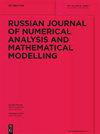Fontan循环患者的双尺度血流动力学模型
IF 0.6
4区 数学
Q4 MATHEMATICS, APPLIED
Russian Journal of Numerical Analysis and Mathematical Modelling
Pub Date : 2021-11-01
DOI:10.1515/rnam-2021-0022
引用次数: 1
摘要
摘要缓解先天性单心室心脏缺陷需要多阶段的手术干预,将下腔静脉和上腔静脉的血流直接转移到左右肺动脉,跳过右心室。这种具有腔肺吻合和单个左心室的系统被称为Fontan循环,重新连接的区域被称为全腔肺连接(TCPC)。计算血流模型使临床医生能够预测Fontan手术的结果,选择TCPC的最佳配置,从而减少术后的负面后果。我们为一名接受Fontan手术的患者提出了一个系统循环的双尺度(1D3D)血液动力学模型。我们使用CT和4D流MRI数据对模型进行个性化设置。该模型根据患者的数据进行了调整,能够表示TCPC入口和出口处测量的时间平均流速,以及处于水平位置的患者的TCPC中的压力。我们证明,改变为静止站立姿势会导致区域(TCPC)和全球血流动力学的其他模式。这证实了Fontan患者运动不耐受的临床数据。本文章由计算机程序翻译,如有差异,请以英文原文为准。
Two-scale haemodynamic modelling for patients with Fontan circulation
Abstract Palliation of congenital single ventricle heart defects suggests multi-stage surgical interventions that divert blood flow from the inferior and superior vena cava directly to the right and left pulmonary arteries, skipping the right ventricle. Such system with cavopulmonary anastomoses and single left ventricle is called Fontan circulation, and the region of reconnection is called the total cavopulmonary connection (TCPC). Computational blood flow models allow clinicians to predict the results of the Fontan operation, to choose an optimal configuration of TCPC and thus to reduce negative postoperative consequences. We propose a two-scale (1D3D) haemodynamic model of systemic circulation for a patient who has underwent Fontan surgical operation. We use CT and 4D flow MRI data to personalize the model. The model is tuned to patient’s data and is able to represent measured time-averaged flow rates at the inlets and outlets of TCPC, as well as pressure in TCPC for the patient in horizontal position.We demonstrate that changing to quiescent standing position leads to other patterns of blood flow in regional (TCPC) and global haemodynamics. This confirms clinical data on exercise intolerance of Fontan patients.
求助全文
通过发布文献求助,成功后即可免费获取论文全文。
去求助
来源期刊
CiteScore
1.40
自引率
16.70%
发文量
31
审稿时长
>12 weeks
期刊介绍:
The Russian Journal of Numerical Analysis and Mathematical Modelling, published bimonthly, provides English translations of selected new original Russian papers on the theoretical aspects of numerical analysis and the application of mathematical methods to simulation and modelling. The editorial board, consisting of the most prominent Russian scientists in numerical analysis and mathematical modelling, selects papers on the basis of their high scientific standard, innovative approach and topical interest.
Topics:
-numerical analysis-
numerical linear algebra-
finite element methods for PDEs-
iterative methods-
Monte-Carlo methods-
mathematical modelling and numerical simulation in geophysical hydrodynamics, immunology and medicine, fluid mechanics and electrodynamics, geosciences.

 求助内容:
求助内容: 应助结果提醒方式:
应助结果提醒方式:


